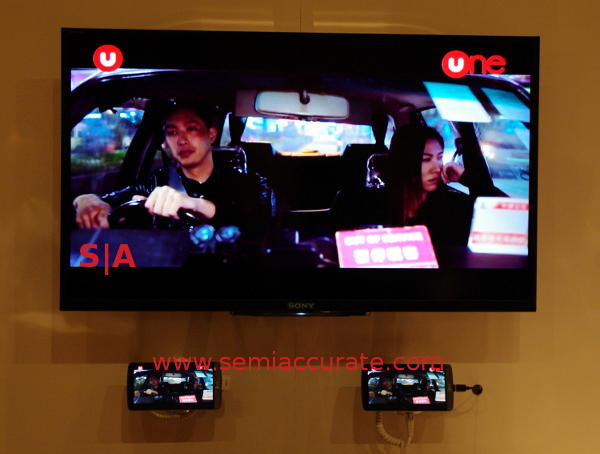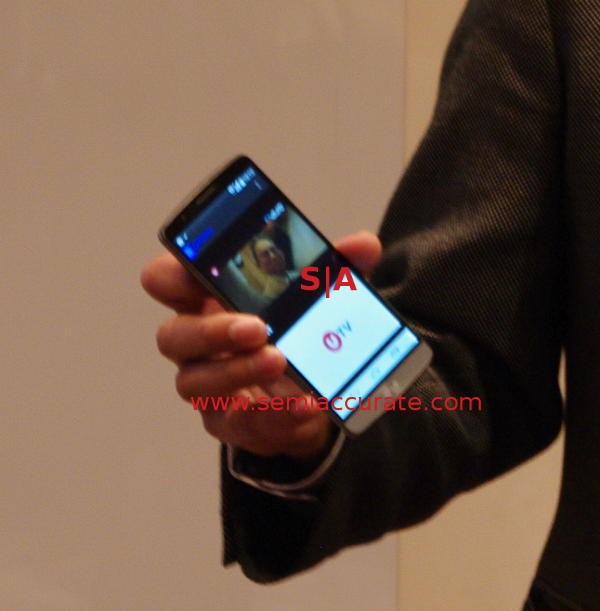 SemiAccurate was shown a live LTE-Broadcast demo in Hong Kong last week by Qualcomm, Ericsson, LG, and China Mobile. The net result was four HD channels streamed over LTE across a live cellular network.
SemiAccurate was shown a live LTE-Broadcast demo in Hong Kong last week by Qualcomm, Ericsson, LG, and China Mobile. The net result was four HD channels streamed over LTE across a live cellular network.
The technology behind the demo is LTE Broadcast (LTE-B), a standard that does pretty much what it says. LTE-B is a multicast technology that can use up to 60% of the available bandwidth to stream video content to multiple devices simultaneously. This saves massive amounts of bandwidth and future versions of the spec allow 100% spectrum allocation for broadcast. Instead of unicasting video, a huge bandwidth hog, you can send popular streams to everyone in the cell at once.

Four streams at once over live spectrum
In the demos SemiAccurate saw about 50-60% of the available bandwidth from the 5MHz of spectrum China Mobile had allocated was used to send four ~1.2Mbps 1080p H.265 streams. This same bandwidth would only support 1-2 unicast users streaming in traditional ways, LTE-B can deliver four streams to everyone in the cell at once with that. Broadcast can radically drop bandwidth use across a cell, with a breakeven point of 2-4 users it is almost a no-brainer for cell operators.
One interesting technical note is that LTE-B can be used to cache content without interrupting the user’s primary communications or data. Vastly simplifying things it uses time slices that the user is not primarily on. Since the radio effectively gets all the slices and ignores the ones it does not actively ‘use’, the rest is downloaded for ‘free’. How much and for what purposes this data is used is more of a software question but the possibilities are fairly limitless, video streaming is just the start. Think replay clips broadcast and cached if you are at a game, they would be there when you need them for zero added bandwidth.
The demo SemiAccurate saw was a version of China Mobile’s UTV, a Wi-Fi video streaming service currently available in Hong Kong. SemiAccurate’s Leo Yim said it is currently live and fairly widely used in Hong Kong but being Wi-Fi only limited its use to static locations. With four HD streams over LTE, UTV will be completely untethered when this new variant eventually goes live.
In the demo the handsets were standard off the shelf LG G3’s with Qulacomm LTE Advanced radios. The back-end was all Ericsson equipment and the content was being streamed from China Mobile’s standard video servers. In short it was production equipment streaming to production handsets live over public spectrum. If you are in Hong Kong it probably won’t be long before you can use this service for real, KT has a two channel commercial LTE-B service in Korea now. The US, well we are backward and broken so it will be quite a wait for us but all the signs say Verizon will be the first to jump.

Note: I know one is a logo but two streams did work
UTV software was pretty slick as well with the TV seen above playing the content from the LG phone below it. You could swipe between the four channels live, split-screen with two live streams, or thumbnail all four, something that worked nicely on the phone’s 4MP screen. All you would need for a LTE-B ‘cable box’ or media center is an HDMI cable and power, the idea has a lot of promise especially in light of the low-end Qualcomm 210 line just announced. If you can make a $100 phone you could easily make a <$50 LTE-B set-top box running Android.
On the slightly darker side you can imagine the possibilities for targeted ads and the like. Even through passive means cell towers can triangulate your position to within about 30 feet and micro/picocells can narrow that down farther too. Cell companies have a lot of demographics on you so if you are watching a video near store X or restaurant Y, they can send you a very àpropos ad at the next commercial break. LTE-B makes targeting groups of 10-20 users feasible, something that changes the game for how video is used and monetized.
Whether or not it’s uses are a good thing for users is a slightly tangential question, the technology is unquestionably a good thing. It can make stadiums and events more interactive, video streaming to mobile devices possible without breaking the networks, and allow for new form factors not currently possible over 3G/4G. In short it is a game changer that will start out by replacing current models with lower bandwidth then evolve rapidly to become something quite different. It will be fun to watch, there are undoubtedly some killer apps already lurking on this one.S|A
Charlie Demerjian
Latest posts by Charlie Demerjian (see all)
- Microsoft Absolutely Screws Intel and AMD Over AI PCs - May 8, 2024
- Qualcomm Is Cheating On Their Snapdragon X Elite/Pro Benchmarks - Apr 24, 2024
- What is Qualcomm’s Purwa/X Pro SoC? - Apr 19, 2024
- Intel Announces their NXE: 5000 High NA EUV Tool - Apr 18, 2024
- AMD outs MI300 plans… sort of - Apr 11, 2024